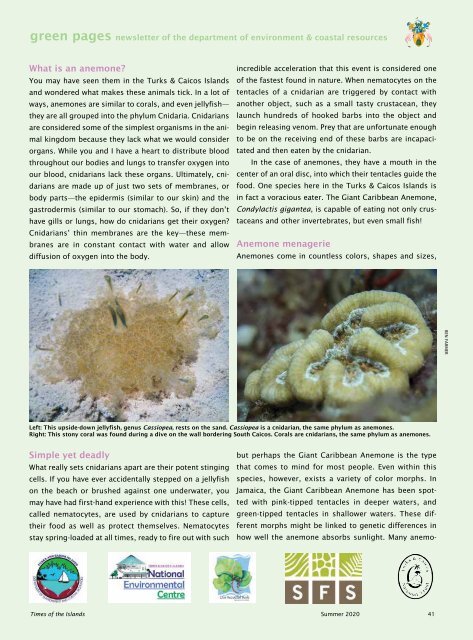Times of the Islands Summer 2020
Presents the "soul of the Turks & Caicos Islands" with in-depth features about local people, culture, history, environment, businesses, resorts, restaurants and activities.
Presents the "soul of the Turks & Caicos Islands" with in-depth features about local people, culture, history, environment, businesses, resorts, restaurants and activities.
Create successful ePaper yourself
Turn your PDF publications into a flip-book with our unique Google optimized e-Paper software.
green pages newsletter <strong>of</strong> <strong>the</strong> department <strong>of</strong> environment & coastal resources<br />
What is an anemone?<br />
You may have seen <strong>the</strong>m in <strong>the</strong> Turks & Caicos <strong>Islands</strong><br />
and wondered what makes <strong>the</strong>se animals tick. In a lot <strong>of</strong><br />
ways, anemones are similar to corals, and even jellyfish—<br />
<strong>the</strong>y are all grouped into <strong>the</strong> phylum Cnidaria. Cnidarians<br />
are considered some <strong>of</strong> <strong>the</strong> simplest organisms in <strong>the</strong> animal<br />
kingdom because <strong>the</strong>y lack what we would consider<br />
organs. While you and I have a heart to distribute blood<br />
throughout our bodies and lungs to transfer oxygen into<br />
our blood, cnidarians lack <strong>the</strong>se organs. Ultimately, cnidarians<br />
are made up <strong>of</strong> just two sets <strong>of</strong> membranes, or<br />
body parts—<strong>the</strong> epidermis (similar to our skin) and <strong>the</strong><br />
gastrodermis (similar to our stomach). So, if <strong>the</strong>y don’t<br />
have gills or lungs, how do cnidarians get <strong>the</strong>ir oxygen?<br />
Cnidarians’ thin membranes are <strong>the</strong> key—<strong>the</strong>se membranes<br />
are in constant contact with water and allow<br />
diffusion <strong>of</strong> oxygen into <strong>the</strong> body.<br />
incredible acceleration that this event is considered one<br />
<strong>of</strong> <strong>the</strong> fastest found in nature. When nematocytes on <strong>the</strong><br />
tentacles <strong>of</strong> a cnidarian are triggered by contact with<br />
ano<strong>the</strong>r object, such as a small tasty crustacean, <strong>the</strong>y<br />
launch hundreds <strong>of</strong> hooked barbs into <strong>the</strong> object and<br />
begin releasing venom. Prey that are unfortunate enough<br />
to be on <strong>the</strong> receiving end <strong>of</strong> <strong>the</strong>se barbs are incapacitated<br />
and <strong>the</strong>n eaten by <strong>the</strong> cnidarian.<br />
In <strong>the</strong> case <strong>of</strong> anemones, <strong>the</strong>y have a mouth in <strong>the</strong><br />
center <strong>of</strong> an oral disc, into which <strong>the</strong>ir tentacles guide <strong>the</strong><br />
food. One species here in <strong>the</strong> Turks & Caicos <strong>Islands</strong> is<br />
in fact a voracious eater. The Giant Caribbean Anemone,<br />
Condylactis gigantea, is capable <strong>of</strong> eating not only crustaceans<br />
and o<strong>the</strong>r invertebrates, but even small fish!<br />
Anemone menagerie<br />
Anemones come in countless colors, shapes and sizes,<br />
BEN FARMER<br />
Left: This upside-down jellyfish, genus Cassiopea, rests on <strong>the</strong> sand. Cassiopea is a cnidarian, <strong>the</strong> same phylum as anemones.<br />
Right: This stony coral was found during a dive on <strong>the</strong> wall bordering South Caicos. Corals are cnidarians, <strong>the</strong> same phylum as anemones.<br />
Simple yet deadly<br />
What really sets cnidarians apart are <strong>the</strong>ir potent stinging<br />
cells. If you have ever accidentally stepped on a jellyfish<br />
on <strong>the</strong> beach or brushed against one underwater, you<br />
may have had first-hand experience with this! These cells,<br />
called nematocytes, are used by cnidarians to capture<br />
<strong>the</strong>ir food as well as protect <strong>the</strong>mselves. Nematocytes<br />
stay spring-loaded at all times, ready to fire out with such<br />
but perhaps <strong>the</strong> Giant Caribbean Anemone is <strong>the</strong> type<br />
that comes to mind for most people. Even within this<br />
species, however, exists a variety <strong>of</strong> color morphs. In<br />
Jamaica, <strong>the</strong> Giant Caribbean Anemone has been spotted<br />
with pink-tipped tentacles in deeper waters, and<br />
green-tipped tentacles in shallower waters. These different<br />
morphs might be linked to genetic differences in<br />
how well <strong>the</strong> anemone absorbs sunlight. Many anemo-<br />
<strong>Times</strong> <strong>of</strong> <strong>the</strong> <strong>Islands</strong> <strong>Summer</strong> <strong>2020</strong> 41

















